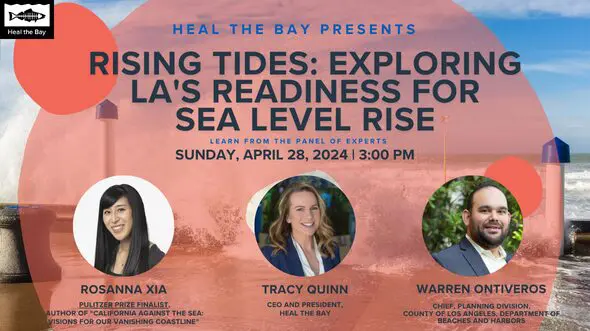Heal the Bay's Top 3 Fixes for the Drought
L.A. needn’t be so dumb in a time of perilous drought. Here’s Heal the Bay’s top three fixes.
California faces an uncertain water future. The record drought coupled with climate change and other stressors has called into question the practicality of importing 80% of L.A.’s water supply. Simply put, imported water is unreliable and expensive. Desalination plants are incredibly energy intensive and create a whole slew of environmental challenges. Instead, our region needs to be smarter about maximizing the water that we already have. The alternative is not rosy: an unsecure water supply at a much higher cost.
Capturing Stormwater and Other Urban Runoff
Dumb: Each day roughly 10 million gallons of urban runoff flows through L.A County stormdrains, picking up pollutants and flowing directly into the sea without the benefit of any treatment. It’s why many of our beaches remain chronically polluted. The waste on our shorelines is terrible, but the waste of water in a time of extreme drought is equally maddening.
Smart: Capturing that runoff and recharging it into our aquifers so that it can be used to augment local water supply.
The potential: After a storm, as much as 10 billion gallons of water is wasted flowing into the sea from stormdrains. That’s enough to fill 100 Rose Bowls!
How to get there: It will take significant resolve and funding, but watershed management plans that prioritize building multi-beneift stormwater capture projects must be implemented.
What Heal the Bay is doing: Our policy team is helping to shape watershed management plans for our region over the coming year. Our staff scientists are playing a lead role with the City of Los Angeles to develop a public funding mechanism to build critical projects. We hope to get funding in place for 2016.
Recycling Treated Wastewater
Dumb: Each day, dischargers send millions of gallons of highly treated wastewater into local rivers and the Pacific Ocean. It’s not helping water quality, and it’s certainly not helping us combat drought.
Smart: Recycling wastewater to help offset potable water use and inject recycled water to replenish our aquifers.
The potential: Each day the Hyperion Treatment Plant discharges up to 450 million gallons of wastewater into Santa Monica Bay. If highly cleansed water was recycled, it could eventually supply enough water for daily use by 1.8 million people.
How to get there: We need to reuse every drop we have, rather than just importing increasingly scarce water.About 2.4 million Orange County residents get their water from a massive aquifer, which has been recharged with billions of gallons of highly cleansed wastewater. Los Angeles can follow Orange County’s lead, and move beyond “toilet to tap” fears. (We prefer Mayor Garcetti’s term: “showers to flowers.”) We need to spend the capital to enhance treatment levels at many facilities and expand the recycled water infrastructure
What Heal the Bay is doing: We are advocating for the implementation of the Los Angeles Groundwater Replenishment Project, which will use up to 30,000 acre-feet per year of highly purified water from the Donald C. Tillman Water Reclamation Plant to replenish the San Fernando Groundwater Basin. Environmental review is already underway, and the City of Los Angeles hopes to meet this goal by 2035 or sooner.
Cleaning Up Our Local Aquifers
Dumb: Allowing contaminated plumes to expand in our aquifers, thereby reducing our local groundwater supply. The San Fernando Groundwater Basin is contaminated primarily due to improper handling and disposal of solvents since the 1940s.
Smart: Treating the contaminated groundwater so that it can be used as a source and so the aquifers can be used as a type of “storage” for recharged stormwater and recycled water.
The potential: The City has the rights to pump up to 87,000 acre-feet of water annually. That’s enough water to meet the demands of the greater L.A. Basin for two months out of the year.
How to get there: We need to allocate significant funds to clean up the groundwater, but in time of persistent drought it will serve as a sound investment.
What Heal the Bay is doing: Our advocacy staff supports funding through Proposition 1 and the Metropolitan Water District to help clean up the San Fernando Valley aquifer. LADWP hopes to have the remediation facilities in operation by 2022.
Improved water supply and improved water quality are inextricably linked. Heal the Bay will continue to advocate for smart projects that help us achieve both goals. The drought will require sacrifice and investment. Let’s just make sure we are investing wisely.



